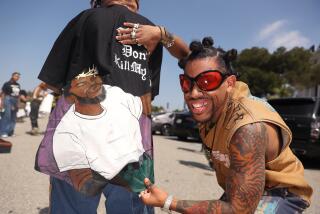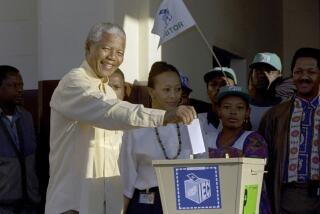Brooklyn Glad to Wait for Hero : Mandela: Motorcade is more than two hours late in reaching the scene of recent racial problems. But 100,000 greet the activist from South Africa.
- Share via
NEW YORK — New Yorkers are not known for their patience and forbearance, but, on Wednesday, a crowd estimated at 100,000 in racially troubled Brooklyn happily waited for hours in summerlike heat for a glimpse of a man whose own endurance has become an inspiration in the international struggle for racial justice.
Nelson Mandela’s motorcade was more than two hours behind schedule when it finally passed Diane Moore, who had been keeping a vigil on the curb of Fulton Avenue in the Bedford-Stuyvesant section of central Brooklyn. She broke into tears and hugged her 9-year-old daughter, April.
“This is history, man! I’m telling you. It’s worth the wait,” she said. “If he waited for 27 years in prison, we can wait nine or 10 hours to see him.”
Many of Mandela’s supporters said it was crucial for him to make a black neighborhood in Brooklyn the first stop of his U.S. tour because the borough has been the scene of several wrenching racial episodes in recent months, including the murder of a black teen-ager in Bensonhurst by a white mob and the boycott of a Korean grocery by black protesters.
“Black youth are finally realizing that the struggle in South Africa is the same as the struggle here,” said 18-year-old Lumumba Bandele, an organizer of a Mandela rally on an athletic field behind Boys and Girls High School, where Mandela gave a brief address. “We felt it necessary for him to come speak to the people of Brooklyn who have been struggling so long to free him and free all of South Africa.”
Among those who spoke at the rally before Mandela’s arrival were Cedric Sandiford and his wife, Jean Griffith, whose son was chased to his death in 1986 by a gang of whites in Queens’ Howard Beach area. The group pursued 23-year-old Michael Griffith onto the Belt Parkway, where he was struck by a car.
“I would not have missed (the rally) for the world,” said Sandiford, who had been severely beaten with a baseball bat by the same group of youths.
Some schools emptied for the day, so their students could witness history firsthand. Angela Youngblood beamed as her first-grade students waved little Pan- African flags fashioned from construction paper, glue and Popsicle sticks. “This is a once-in-a-lifetime thing--for them, for me,” she said.
The streets along the motorcade route were lined with thousands of spectators, who held up a forest of signs, banners and placards. The entrepreneurial spirit flourished as well, with one plaza near the school becoming a bazaar of souvenir T-shirts and buttons.
The long delay was a boon to a street vendor selling fried chicken from a card table. She not only managed to sell all 40 pieces she prepared the night before but had time to leave, shop for more chicken, go home, cook it and return before the motorcade came through.
For many, the reward for hours of waiting was only a momentary glimpse of a line of limousines. Giselle Orridge and her 9-year-old son, Shawn Roberts, were not certain whether they actually saw Mandela behind the tinted window of his black limousine. “But that doesn’t matter,” she said. “Just being here is the important thing.”
“He’s a real great man,” said Brian Boone, a first-grader waiting along the motorcade route with his class from Public School 21. “He means a lot to me because he’s free from prison now. Maybe he could free New York City.”
It was rumored several times that Mandela would not stop for the schoolyard rally because he was already late for subsequent events that had been scheduled in Manhattan. But the crowd of thousands, some of whom had shown up shortly after dawn, remained.
Ironically, many of the students of Boys and Girls High could not attend the huge event being held outside their school because they were inside the building taking statewide examinations. The school, which had been regarded as one of New York’s worst, has been held up in recent years as an inner-city success story.
“They say we’re the best high school in Bed-Stuy,” said 17-year-old Kenyata James, an 11th-grader who was not one of those required to take tests. He attended the rally in a T-shirt bearing the school name and announcing: “I am an achiever.”
Mandela made education the central theme of his 11-minute address. He told the crowd that, in South Africa, “the education available to blacks is far inferior to that available to whites.”
“The same thing here!” several people yelled back.
Halfway through his speech, the impatient crowds finally had had enough of police barricades, which had held them back from the stage for hours, and scrambled over them for a better glimpse of Mandela and his wife, Winnie.
More to Read
Sign up for Essential California
The most important California stories and recommendations in your inbox every morning.
You may occasionally receive promotional content from the Los Angeles Times.










